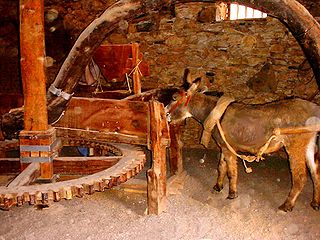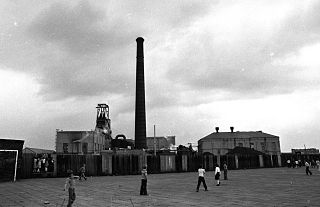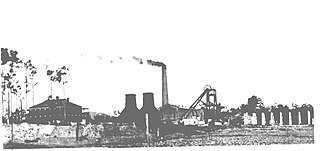
The Racecourse Colliery is an exhibit located at the Black Country Living Museum.

The Racecourse Colliery is an exhibit located at the Black Country Living Museum.
The Black Country Living Museum has more than 40 old mine shafts on its site, [1] which have largely been lost, in-filled, collapsed, stabilised or capped. One of the original surviving shafts has been used to create the Racecourse Colliery exhibit. It was originally the shaft of one of the Earl of Dudley's small pits, Coneygree Colliery Pit No 126, which operated between 1860 and 1902. After the pit was abandoned, all the surface landmarks were removed and the shaft itself was eventually filled in. [2]
Work started on the creation of the Racecourse Colliery exhibit in 1979 and, with the exception of the head frame, all work was carried out on Sundays by volunteers from the Birmingham Enterprise Club and the Friends of the Black Country Museum Mining Group. The colliery was re-created following exactly the same sequence as the creation of an actual working Black Country pit. The shaft was re-opened to a depth of 64 feet (its original depth was between 100 and 120 feet). The lining brickwork was also repaired. The coal obtainable from this pit is Bottom Coal- about 100 ft down. Close to this exhibit another original shaft was used to create Racecourse Colliery Number Two Pit, also referred to as Brook Shaft. Here coal was worked at 30 ft and has 8 ft of Bottom Coal showing. Moulds from this shaft were used to create the 'coal' for the museum's underground drift mine experience, 'Into the Thick'.
Other principal coal seams in the South Staffordshire Coalfield include Brooch, Flying Reed, Upper Heathen, Stinking (sulphur), New Mine, Fireclay and the famous Thick Coal. [3]
The buildings and other features of the Racecourse Colliery are either replicas of known mining landmarks, or have been devised on the basis of photographs and existing knowledge of old Black Country pits. The exception to this is the Weighbridge House which is a historic building, relocated from Rolfe Street in Smethwick, where it stood in the Birmingham Canal Navigation's wharf yard. It was probably built in the early years of the 20th century. The reconstruction at Black Country Living Museum has been called Racecourse Colliery because the land on which it stands was originally the Earl of Dudley's private racecourse, which was closed when the railway line from Dudley to Wolverhampton was built in 1852. [4]

This pit features a Manager's Office and a Weighbridge Office that sit side by side. Many of the small pits did not have a resident manager instead, one manager would look after a number of pits. One of the manager's jobs was to make sure that all the mine plans were kept up-to-date, these plans would have been kept in the office. There are no safety lamps in the office; many Black Country pits did not use them as working lights because the shallow workings enabled some of the volatile gases to escape to the surface. Mines like this were known as 'naked lamp' mines, i.e. the miners would have to make do with tallow candles set in a lump of clay. [4]
Mines were run on a day-to-day basis by the butty, this position can be compared to the modern-day contactor who would agree to sell coal to the mine owner at a fixed price. [5] The butty would also hire and fire the men as required and at a pit like this, between six and 30 men could be employed. Every morning before the start of the shift the butty would go down with his safety lamp and check the workings for gases and to see if any more pit props were required. [4]
At 6.30 in the morning the miners started work. They were lowered down the shaft in a cage (by the head frame). These cages were also used to bring up coal as it was mined. A Winding engine housed in a brick building would operate the cage. [4]

The winding house at the museum is a replica based on the one that used to stand at Amblecote Colliery No.2 Pit. At the back of the building is the large drum which holds the wire rope that runs over the wheel at the top of the head frame and lifts the cage. This drum is rotated by a Steam engine inside the engine house. The steam to power the engine would have come from the Egg-ended boiler in front of the engine house. Heating all the water in the boiler to convert it to steam took a long time so the fire beneath the boiler was kept lit all the time. The engine operator kept the fire stoked during the day, but at about 3pm when the shift ended the fire would be banked up and left overnight. The museum does not use this boiler to raise steam when it operates the colliery winder, instead a smaller Vertical boiler is used which is housed at the rear of the engine house.
Apart from using the winding engine to raise and lower the miners and the coal tubs, the winding engine would also have been used to remove water from the pit. This was done by a process called tanking. After 1864 all coal miners had to have two head frames and two shafts to provide an extra way out of the workings in an emergency. The second shaft would be situated over the lowest point of the pit so that all the water would gather there in a sump. The winding engine would lower a tank into the sump, a special valve enabled the tank to fill with water, the tank was then raised and someone on the surface pulled a lever one the tank to discharge the water from the pit. There is one of these tanks lying at the side of the miner's hovel.
To the side of the brick engine shed is a small corrugated building which houses the engine and fan. This was installed to provide adequate ventilation in a mine. The engine is from Amblecote Fireclay Pit c1860 and was made by J. C. Stark of Torquay. It was found dismantled in the Orangery at Shugborough. The fan sucks the air from the pit. The upright part is called the evaze and is designed to dissipate the air. [4]
The Headframe is a replica of the one that used to stand at the Amblecote Colliery Pit No.12. At the bottom of the shaft was the on-setter, the man whose job it was to load the coal tubs into the cages. When the cage was loaded he would shout or signal (via the bell fixed to the head frame) to the man at the top the shaft, the banks man. He in turn would signal to the engine operator to raise the cage. At the top the banks man would take the truck from the cage, push it along the rails to the land sale wharf. The rails are laid on a slope above the wharf and loaded up with coal. [4]

The miners' Hovel is the workmen's mess room and the place where miners could dry their wet pit clothes at the end of the day. A fire was kept lit in the hovel and wet clothes left hanging in there overnight were usually dry again by morning. The men could also brew a hot drink in the hovel, eat their 'snap'(lunch usually in a tin [6] or cloth covered bowl) or fry bacon and egg on a shovel over the fire. In some pits with a good boss, a barrel of beer may be provided to take underground. [4]
The Blacksmith's Shop was for keeping the miners' picks sharp, they had to be kept sharp to cut the coal. Tools were sharpened by heating and hammering rather than sharpening with a file. The tools had to be kept sharp in order to get fast results. If a pit did not have a blacksmith the picks would be regularly taken along to the nearest local blacksmith for sharpening. The forge would also be used for making or repairing wrought iron equipment or tub bodies. Rattle chain (Black Country term for flat winding chain [7] ) would have been repaired by the blacksmith. The chain was wound on a narrow reel similar to camera film, not on a drum, and rattled as it wound. Metal tyres for wooden wheels were heated on the forge and the shrunk onto the wooden wheels. [4]

The atmospheric engine was invented by Thomas Newcomen in 1712, and is often referred to as the Newcomen fire engine or simply as a Newcomen engine. The engine was operated by condensing steam drawn into the cylinder, thereby creating a partial vacuum which allowed the atmospheric pressure to push the piston into the cylinder. It was historically significant as the first practical device to harness steam to produce mechanical work. Newcomen engines were used throughout Britain and Europe, principally to pump water out of mines. Hundreds were constructed throughout the 18th century.

The Black Country Living Museum is an open-air museum of rebuilt historic buildings in Dudley, West Midlands, England. It is located in the centre of the Black Country, 10 miles west of Birmingham. The museum occupies 10.5 hectares of former industrial land partly reclaimed from a former railway goods yard, disused lime kilns, canal arm and former coal pits.

Beamish Museum is the first regional open-air museum, in England, located at Beamish, near the town of Stanley, in County Durham, England. Beamish pioneered the concept of a living museum. By displaying duplicates or replaceable items, it was also an early example of the now commonplace practice of museums allowing visitors to touch objects.
Murton is a village in County Durham, England. Lying eight miles (13 km) east of the city of Durham and six miles (9.7 km) south of Sunderland, it has a population of 4,534, increasing to 7,676 at the 2011 Census.

Big Pit National Coal Museum is an industrial heritage museum in Blaenavon, Torfaen, Wales. A working coal mine from 1880 to 1980, it was opened to the public in 1983 as a charitable trust called the Big Pit (Blaenavon) Trust. By 1 February 2001 Big Pit Coal Museum was incorporated into the National Museums and Galleries of Wales as the National Mining Museum of Wales. The site is dedicated to operational preservation of the Welsh heritage of coal mining, which took place during the Industrial Revolution.

The National Coal Mining Museum for England is based at the site of Caphouse Colliery in Overton, Wakefield, West Yorkshire, England. It opened in 1988 as the Yorkshire Mining Museum and was granted national status in 1995.

A horse mill is a mill, sometimes used in conjunction with a watermill or windmill, that uses a horse engine as the power source. Any milling process can be powered in this way, but the most frequent use of animal power in horse mills was for grinding grain and pumping water. Other animal engines for powering mills are powered by dogs, donkeys, oxen or camels. Treadwheels are engines powered by humans.

The Oaks explosion, which happened at a coal mine in West Riding of Yorkshire on 12 December 1866, remains the worst mining disaster in England. A series of explosions caused by firedamp ripped through the underground workings at the Oaks Colliery at Hoyle Mill near Stairfoot in Barnsley killing 361 miners and rescuers. It was the worst mining disaster in the United Kingdom until the 1913 Senghenydd explosion in Wales.

Ryhill is a small village and civil parish situated on the B6428 road in West Yorkshire, England approximately 7 miles (11 km) south-east of the city of Wakefield. It has a population of 2,628, increasing to 2,894 at the 2011 census.

Cefn Coed Colliery Museum is a former coal mine, now operating as a museum. It is located at Crynant near Neath in the South Wales Valleys.


Chatterley Whitfield Colliery is a disused coal mine on the outskirts of Chell, Staffordshire in Stoke on Trent, England. It was the largest mine working the North Staffordshire Coalfield and was the first colliery in the UK to produce one million tons of saleable coal in a year.

Parsonage Colliery was a coal mine operating on the Lancashire Coalfield in Leigh, then in the historic county of Lancashire, England. The colliery, close to the centre of Leigh and the Bolton and Leigh Railway was sunk between 1913 and 1920 by the Wigan Coal and Iron Company and the first coal was wound to the surface in 1921. For many years its shafts to the Arley mine were the deepest in the country. The pit was close to the town centre and large pillars of coal were left under the parish church and the town's large cotton mills.
Chanters Colliery was a coal mine which was part of the Fletcher, Burrows and Company's collieries at Hindsford in Atherton, Greater Manchester, then in the historic county of Lancashire, England.
Mosley Common Colliery was a coal mine originally owned by the Bridgewater Trustees operating on the Manchester Coalfield after 1866 in Mosley Common, Greater Manchester, then in the historic county of Lancashire, England. The colliery eventually had five shafts and became the largest colliery on the Lancashire Coalfield with access to around 270 million tons of coal under the Permian rocks to the south.

Bradford Colliery was a coal mine in Bradford, Manchester, England. Although part of the Manchester Coalfield, the seams of the Bradford Coalfield correspond more closely to those of the Oldham Coalfield. The Bradford Coalfield is crossed by a number of fault lines, principally the Bradford Fault, which was reactivated by mining activity in the mid-1960s.
Coal mining played an important part in the history of the Black Country area immediately west of Birmingham, England. It was the basis for the area's industrial development in the nineteenth century; without coal there was insufficient power. Commentators spoke of the Black Country as a great coalfield, and of the earth turned inside out by all the mining activity. Most of the mines were not large scale, but small rough and ready pits similar to the Racecourse Colliery exhibit at the Black Country Living Museum. There were as many as five or six hundred small pits like this exploiting the seams of the South Staffordshire coalfield.
This is a partial glossary of coal mining terminology commonly used in the coalfields of the United Kingdom. Some words were in use throughout the coalfields, some are historic and some are local to the different British coalfields.

Calvert's Engine or the Newbridge Colliery Engine is a beam engine of 1845, now preserved on the campus of the University of Glamorgan, South Wales.

Richmond Main Colliery is a heritage-listed former coal mine and now open-air museum at South Maitland Coalfields, Kurri Kurri, New South Wales, Australia. It was designed by the staff at J & A Brown's Engineering Workshops at Hexham under the direction of John Brown and built from 1908 to 1913 by J & A Brown. The site now operates as the Richmond Main Heritage Park, including the Richmond Vale Railway Museum and Richmond Main Mining Museum. The property is owned by Cessnock City Council. It was added to the New South Wales State Heritage Register on 2 April 1999.